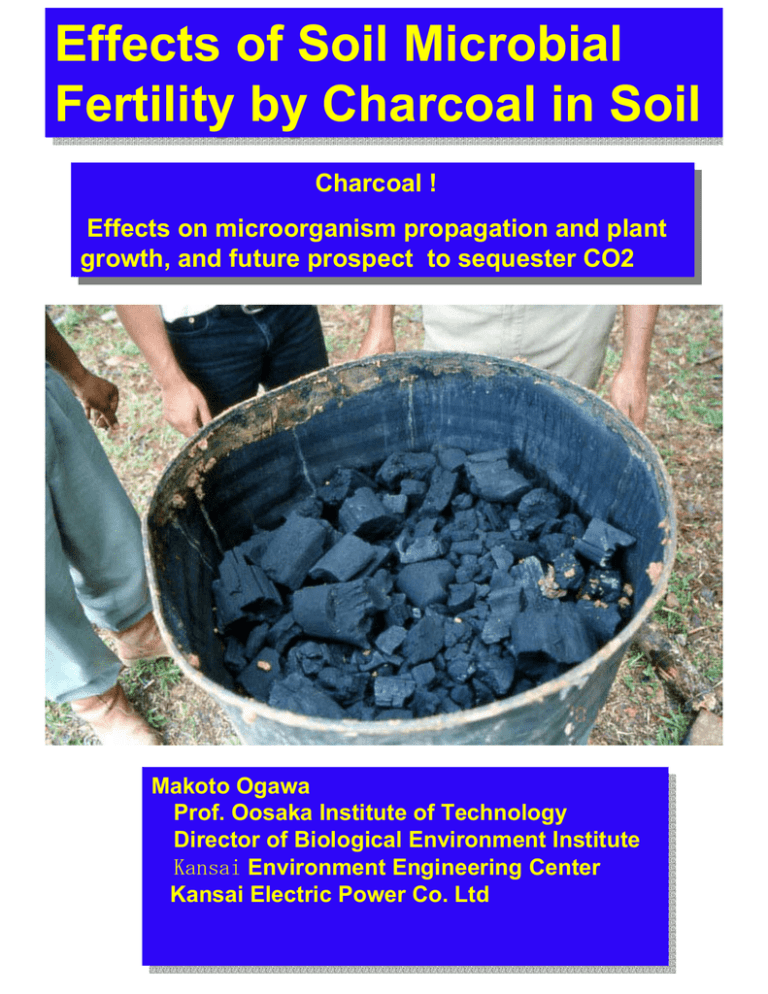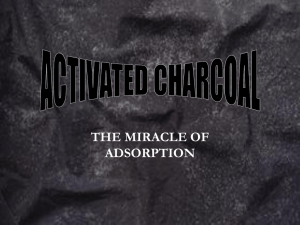Effects of Soil Microbial Fertility by Charcoal in Soil
advertisement

Effects Effects of of Soil Soil Microbial Microbial Fertility Fertility by by Charcoal Charcoal in in Soil Soil Charcoal Charcoal!! Effects Effectson onmicroorganism microorganismpropagation propagationand andplant plant growth, growth,and andfuture futureprospect prospect to tosequester sequesterCO2 CO2 Makoto MakotoOgawa Ogawa Prof. Prof.Oosaka OosakaInstitute Instituteof ofTechnology Technology Director of Biological Environment Director of Biological EnvironmentInstitute Institute Kansai KansaiEnvironment EnvironmentEngineering EngineeringCenter Center Kansai KansaiElectric ElectricPower PowerCo. Co.Ltd Ltd Introduction Introduction Cunsumption Cunsumption and and Impo Impo rt rt of of Charcoal Charcoal Marketing Marketingof ofnew-use new-usecharcoal charcoalexcept except for forfuel fuel in inJapan Japan(Charcoal (CharcoalAsoc.1999) Asoc.1999) Materials Materialsfor forconstruction construction - -Conditioner Conditionerofofhumidity humidityininhouse, house,- -Thermal Thermal conditioner conditionerininwall, wall, 1. Characteristics of Charcoal and It’s Functions Micr Microstr ostructu ucture re of Char of Charcoal coal Charactaristics Charactaristics and and Functions of Functions of C C harcoal harcoal 1. Porous substance with high water and air holding capacity; Suitable habitat for some microbes and plant growth, good material for soil amendment, absorption of chemicals and humidity control 2. High alkalinity ; Neutralization of acidic soil and improvement of chemical components of soil and selection of microorganisms 3. Non organic matter ; Exclusion of saprophytes and propagation of autotrophic and symbiotic microorganisms, free living nitrogen fixing bacteria, root nodule bacteria, Frankia and some mycorrhizal fungi 4. Low mineral content ; “Charcoal has no roles as a fertilizer” Composition of bark charcoal % Carbon:77.58, Volatile Substances:12.92, Ash: 9.50 Mineral contents of ash % SiO2:36.5, Al2O3:10.9, CaO:19.2, K2O:1.1, Na2O3:5.35, Fe2O3:7.5, MgO:10.3, P2O5:1.7 # Air supply by charcoal induces the activation of soil microbes and CO2 emission temporally. Small amount of chemical fertilizers or organic matters should be mixed with charcoal in agricultural use. Improvement Improvement of of soil soil physica physica l l properties properties by by charcoal charcoal (Takasago (Takasagoet etal. al.Kasima KasimaReport Report1996) 1996) 2. Effects on Ectomicorrhiza and Tree Growth Trees, Mycorrhizae, Mushrooms and Charcoal Application Applicationof ofcharcoal charcoalto torehabilitation rehabilitation of ofdeclined declinedpine pinetree tree(Ito (Ito1998) 1998) Recovering of Pine Tree from Wilting by Charcoal Treatment after a year The growth of pine root and mycorrhiza formation started at 5 to 6 months after treatment Before 1998 Sep. After 1999 Oct. Inoculation Effect of ectomycorrhizal fungi to Dipterocarps in Indonesia (Ogawa 1989) Fruitbody of Scleroderma No-inoculation Inoculated seedling Stimulation of Ectomycorrhiza Formation on Dipterocarps root by Charcoal Application in Pot Soil Ectomycorrhiza 3. Effects on Root Nodule Formation and Soy bean Yield +Char coal Control -Char coal +phosphate +Phosphate Yield Yieldof ofSoy SoyBean BeanCultivated Cultivatedby byCharcoal Charcoalwith withFertilizers Fertilizers The Theamount amountofoffertilizer fertilizerwas wasadjusted adjusted1% 1%ofofcharcoal charcoalininweight. weight.The Theyield yieldwas was estimated in average of 30 plants. estimated in average of 30 plants. ( (M. M.Ogawa Ogawa1983) 1983) Materials used Pod number Chemical fertilizer (NPK 8:8:8) 100g/m2 85 2 200g/m 106 Charcoal only 500 g/m2 28 1500 g/m2 15 Charcoal with super phosphate 500 113 1500 66 Charcoal with Ammonium sulphate 500 97 1500 102 Charcoal with Urea 500 96 1500 89 Charcoal with NPK fertilizer 500 115 1500 80 Charcoal with oil cake 500 96 1500 106 Control (non treatment) 39 Grain weight g./plant 9.0 13.6 1.7 1.2 14.6 10.1 11.1 10.5 11.1 7.6 10.9 9.6 10.9 12.6 4.6 Effects Effectsof ofrice ricehusk huskcharcoal charcoalon onthe thegrowth growth of ofsoybean soybeanand andMaize Maizein inIndonesia Indonesia(Igarasi (Igarasi 1996) 1996) Chemical ChemicalFertilizer FertilizerPlot Plot Rice Husk Charcoal Plot Charcoal and Lime Plot Soil amendment plan by rice husk charcoal, lime and fertilizer Three kinds of materials were mixed with top soil before the experiment. C: charcoal, F: fertilizer, L: lime. Chemical fertilizer was supplied at 6th crop and charcoal at 5th and 6th . Effect Effectof ofrice ricehusk huskcharcoal charcoalon onthe theyields yieldsof ofsoybean soybeanand and peanut peanutunder underdifferent differentsoil soilcondition condition(Igarasi (Igarasi1996) 1996) Soybean, Soybean,peanut peanutand andcorn cornwere werecultivated cultivatedalternately alternatelyininthe thesame samefield. field.The Theyield yieldinin the plots with charcoal, lime and fertilizer showed the highest yield in any crop. the plots with charcoal, lime and fertilizer showed the highest yield in any crop. Maize was planted after soy bean without fertilizer Fertilizer + Charcoal Chemical fertilizer Control Charcoal only Effect of charcoal on the root growth and nodule formation of Acacia mangium in Indonesia (Okimori, Yamato 2000) Forest floor of Acacia plantation was covered by rice husk charcoal 5 cm in depth. Earthworm population increased soon after the treatment because of neutralization of top soil. Acacia’s root growth started after three months and root biomass increased Root nodule formation was stimulated in charcoal, but the growth response was not so clear after 3 years. 4. 4. Charcoal Charcoalas asaamaterial materialfor forimmobilization immobilizationof of useful usefulmicroorganisms microorganisms ((Spores Sporesof of bacteria, bacteria,root root nodule nodulebacteria, bacteria,mycorrhizal mycorrhizalfungi, fungi,Frankia Frankiaetc etc)) Cross section of the root nodules formed by Frankia sp. Root nodules of Myrica rubra Effect of Charcoal for Inoculation of Frankia (Kurusu) Frankia and other nitrogen fixing bacteria can be immobilized in charcoal. Isolated colony of Frankia sp. using of Frankia medium Cultivation of Frankia sp. using of modified Q-mod liquid medium Effect of Charcoal Compost on Soil Disease Control Charcoal compost is produced being mixed with live stock excretes and fermented. Some thermophilic bacteria which have high productivity of antibiotics propagate in charcoal + Charcoal Control compost Bacterial disease was controlled by the charcoal compost Control VAM inoculated Charcoal compost used 5. Effect of Charcoal on VA mycorrhizal Fungi and Plant Growth Spore of VA mycorrhizal fungi, Gigaspora margarita VA mycorrhiza is essential for phosphate and mineral absorption of many plants Vesicle Arbuscule VA mycorrhiza formed on soy bean root Charcoal is good habitat for some VA mycorrhizal fungi. The germination rate of G. margarita was higher than that on soil (Ogawa 1991) The hyphae growing from spore base invade into the charcoal pore with larger size Effect of inoculation of VA mycorrhizal fungi and charcoal use (Ogawa 1985) Cucumber Control Spore inoculated with charcoal Apple tree seedling Control Three species were inoculated with charcoal 6. 6.Effect Effectof ofCharcoal Charcoalon onthe thepropagation propagationof of Soil SoilBacteria Bacteriaand andFree FreeLiving LivingNitrogen NitrogenFixing Fixing Bacteria Bacteriain inTropical TropicalSoil Soil The frequency of free living nitrogen fixing bacteria in subtropical soil is generally higher than those in temperate zone (Asou et al. in 1924). Bacterial population including aerobic nitrogen fixing bacteria (Beijerinckia) increased when charcoal powder was mixed with top soil in Indonesia. Nitrogen fixation seems to be promoted by charcoal application or shifting cultivation in tropical region. (Ogawa 1992) charcoal con con NPK charcoal NPK Effect of bark charcoal and fertilizer on the plant growth and soil properties in south Sumatra (Yamato 2004 unpublished) Effect of charcoal application on Vigna sequipedalis Total weight (f.w.) of harvested seed pod (g/m2) 3000 First 3000 Second control 2500 2500 2000 2000 Fertilizer 1500 1500 Fertilizer & Charcoal 1000 1000 500 500 0 0 Site 1 3000 First 3000 2500 2500 2000 2000 1500 1500 1000 1000 500 500 0 0 Second Site 2 Average ± S.D. Effect of charcoal application on Zea mays L Total weight (f.w.) of harvested corn (g/m2) 2500 First 2000 2500 Second control 2000 Fertilizer 1500 1500 1000 1000 500 500 0 0 Fertilizer & Charcoal Site 1 2500 First 2500 2000 2000 1500 1500 1000 1000 500 500 0 0 Site 2 Second Average ± S.D. Soil analysis Site 1 (First experiment) Bray 1 Morgan pH pH Total C Total-N P2O5 K2O (H2O) (KCl) (%) (%) (ppm) (ppm) Before Exp. 3.9 3.9 1.63 After harvest of first experiment V. sequipedalis con 4.2 3.9 2.00 1.85 fertilizer 4.1 3.9 charcoal 5.3 4.8 1.62 Z. mays con 4.0 3.8 1.44 fertilizer 4.0 3.8 1.62 charcoal 5.1 4.5 2.44 A. hypogoaea con 4.2 3.9 1.85 fertilizer 4.0 3.9 1.85 charcoal 5.1 4.6 2.53 0.17 47.8 75 0.12 0.18 0.16 25.4 44.0 91.8 40 59 140 0.17 0.19 0.24 22.0 44.5 80.2 40 49 90 0.19 0.18 0.25 55.3 137.5 176.0 60 60 120 Soil analysis cont. Site 1 (First experiment) ;continued Exchangeable cation (meq/100 g) 1N CH3COONH4 Base saturation 1N KCl CEC (%) Al3+ H+ (meq/100g)Ca2+ Mg2+ K+ Na+ Before Exp. 10.12 1.21 0.30 0.15 0.25 18.9 2.67 0.26 After harvest of first experiment V. sequipedalis con 10.81 1.30 0.24 0.08 0.08 15.7 2.49 0.15 1.01 0.28 0.12 0.02 13.4 2.81 0.15 fertilizer 10.66 charcoal 16.42 7.80 0.43 0.29 0.14 52.7 0.02 0.12 Z. mays con 9.87 0.80 0.20 0.12 0.22 13.6 2.93 0.20 0.79 0.18 0.12 0.07 11.3 2.97 0.22 fertilizer 10.23 charcoal 12.72 6.21 0.45 0.25 0.13 55.3 0.12 0.12 A. hypogoaea con 10.21 1.27 0.29 0.08 0.07 16.7 2.41 0.15 0.91 0.22 0.10 0.03 12.6 2.77 0.20 fertilizer 10.01 charcoal 12.66 5.98 0.37 0.18 0.07 52.1 0.15 0.10 7. 7.Effective EffectiveSequestration Sequestrationof ofCO2 CO2 in inAtmosphere Atmosphereand andits itsInactivation Inactivation in inAgriculture Agricultureand andNatural Natural Environment Environment CO2 CO2inin atmosphere atmosphere Carbohydrates in wood (Cellulose, Hemicellulose, Lignin) Photosynthesis by green plants Harvesting Harvestingand and utilization utilizationfor for timber, timber,pulp pulpetc. etc. Carbonization of wood wastes etc 25~70%of wood turns to charcoal by carbonization 80% of wood charcoal is pure carbon Expansion Expansionof ofcarbon-sink carbon-sinkand andcarbon carbon sequestration sequestration are areaapair pairof ofwheels wheels Carbon Carbonsequestration sequestrationproject projectby bycharcoal charcoal utilization utilizationand andforestation forestationin inSouth Southeast eastAsia Asia CCF CCFScheme Scheme(Carbon (CarbonSequestration Sequestrationby byCharcoal CharcoalUtilization Utilization and andForestation) Forestation)proposed proposedby byM. M.Ogawa Ogawain in1998 1998 (KEPCO and Min.of Environment 2000~) Recycling Recyclingsystem systemof ofbiomass biomasswaste wastefor for Carbon Carbonsequestration, sequestration,aatrial trialin inJapan Japan2000 2000 (RITE, (RITE,METI METI2001~2003) 2001~2003) (Ogawa, RITE, METI, and EBARA 2001~2003)





